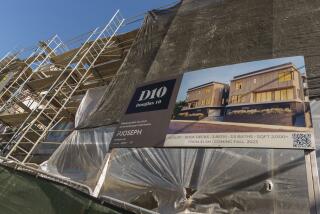ARMs Popular Despite Fall in Fixed Rates, Survey Says
- Share via
WASHINGTON — Even though falling interest rates helped traditional fixed-rate mortgages regain popularity among home borrowers in the last year, adjustable-rate mortgages still made up more than half of all home loans and should remain attractive, a thrift industry study concluded Monday.
The continued appeal of ARMs proves that they have become “a permanent feature of the U.S. mortgage market,” the U.S. League of Savings Institutions said in an annual survey of its members’ home-lending practices. But the survey also suggests that the adjustable mortgages are a rather select feature, because most S&Ls; reported that they grant the loans--which often carry a lower-than-usual interest rate--only to borrowers who meet stricter credit standards.
The poll of 1,100 S&Ls;, conducted in May, concludes that borrowers have shed their fears about the ARMs, whose interest rates are not fixed but are pegged to floating indexes such as the rate on Treasury securities. When first offered in the early 1980s, the mortgages were dogged by borrowers’ fears that monthly payments would soar if inflation drove interest rates sharply upward, forcing defaults.
However, the survey states, a healthy 55% of all home loans last May were ARMs, compared to 69% in May, 1984. That the bottom did not fall out of the ARM market suggests that features such as reduced interest rates and flexibility have helped them to remain popular, said league economist Dennis Jacoby.
“ARMs are here to stay,” agreed Andrew Carron, a mortgage banking expert and vice president of Shearson Lehman Bros. in New York, “although there’s a definite cyclical element to them.”
Virtually all lenders now include some form of protection against “payment shock” in ARM contracts, the industry poll showed. All but 0.8% of the lenders surveyed have placed caps on the maximum interest rates or monthly payments that can be charged borrowers, either over the life of the mortgage or during pre-established periods.
What has changed, the poll concluded, is the index to which most ARMs rates are pegged.
Nearly half of all ARMs in the May, 1984, survey were indexed to the so-called cost-of-funds rate--the interest rate that regional divisions of the Federal Home Loan Bank Board charged S&Ls; to borrow money. But by this May, 71.5% of all ARMs were indexed either to six-month or one-year Treasury bills.
The study said that borrowers prefer the volatile Treasury index, which plummeted during the year as the rate on T-bills fell, over the slow-changing cost-of-funds index, which offers more long-term stability.
Lenders in Los Angeles, one of the cities surveyed, ignored national trends and instead used the cost-of-funds index for 58% of all loans. High housing prices in the Los Angeles area--and the large mortgages that accompany them--may make the more stable funds index more attractive, league officials said.
The poll also reported that most lenders have significantly stiffened credit requirements for ARM borrowers. A total of 55% of lenders surveyed said that their loan standards were stricter for ARMs than for fixed-rate mortgages, compared to 31% in 1984.
The more “prudent underwriting standards,” the league stated, have led to a generally lower default rate for the adjustable mortgages than for other home loans.
More to Read
Inside the business of entertainment
The Wide Shot brings you news, analysis and insights on everything from streaming wars to production — and what it all means for the future.
You may occasionally receive promotional content from the Los Angeles Times.










